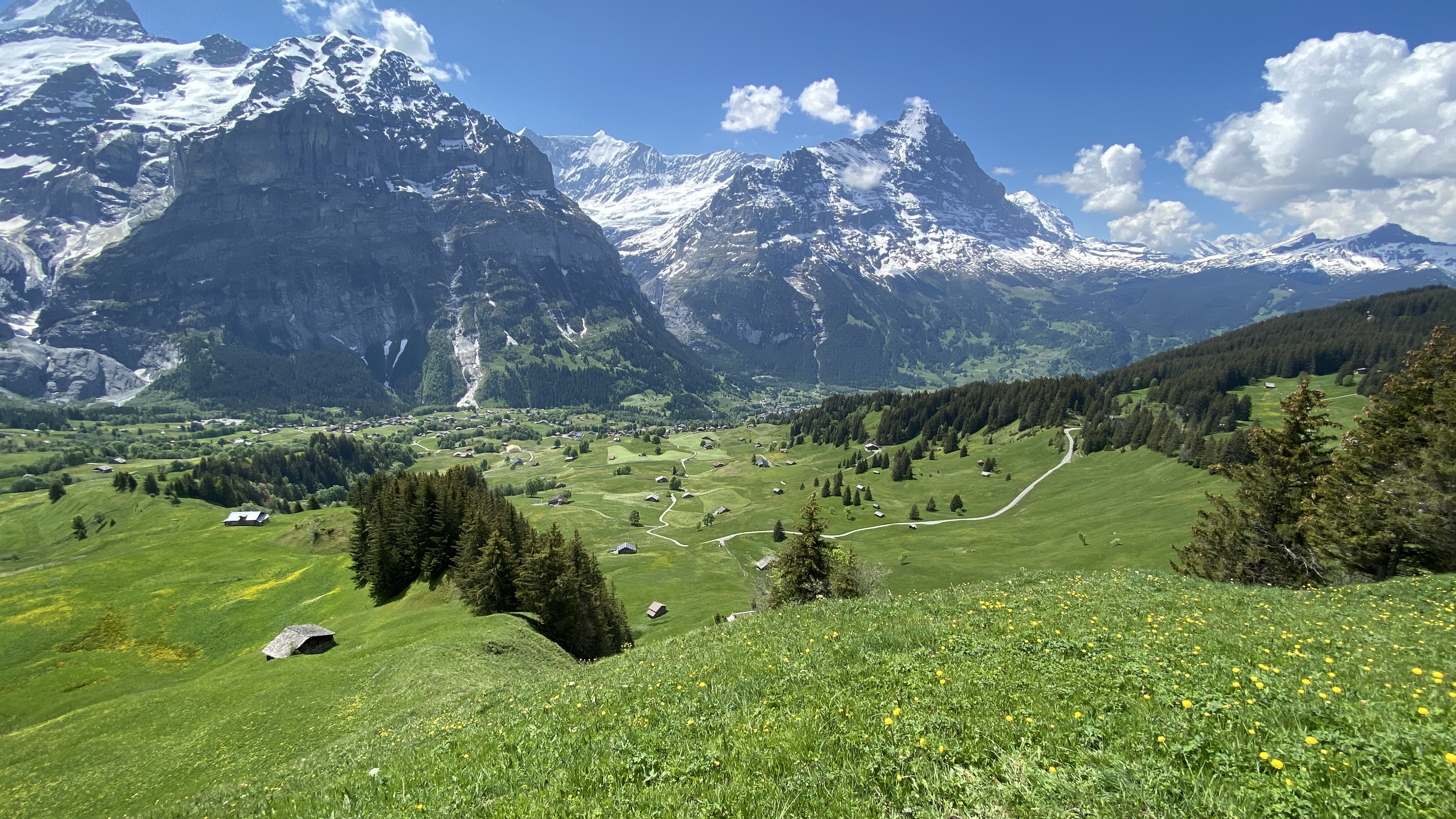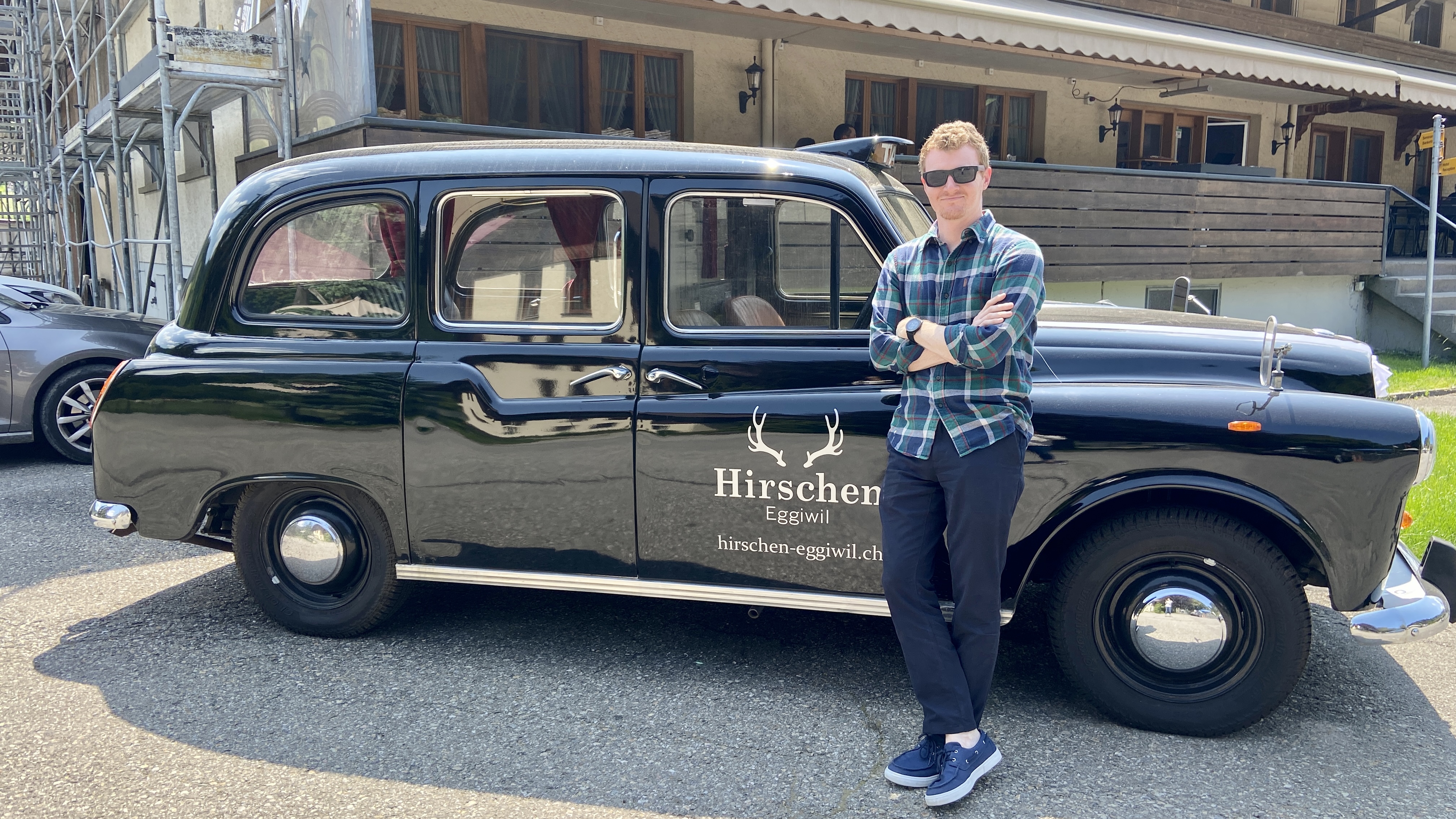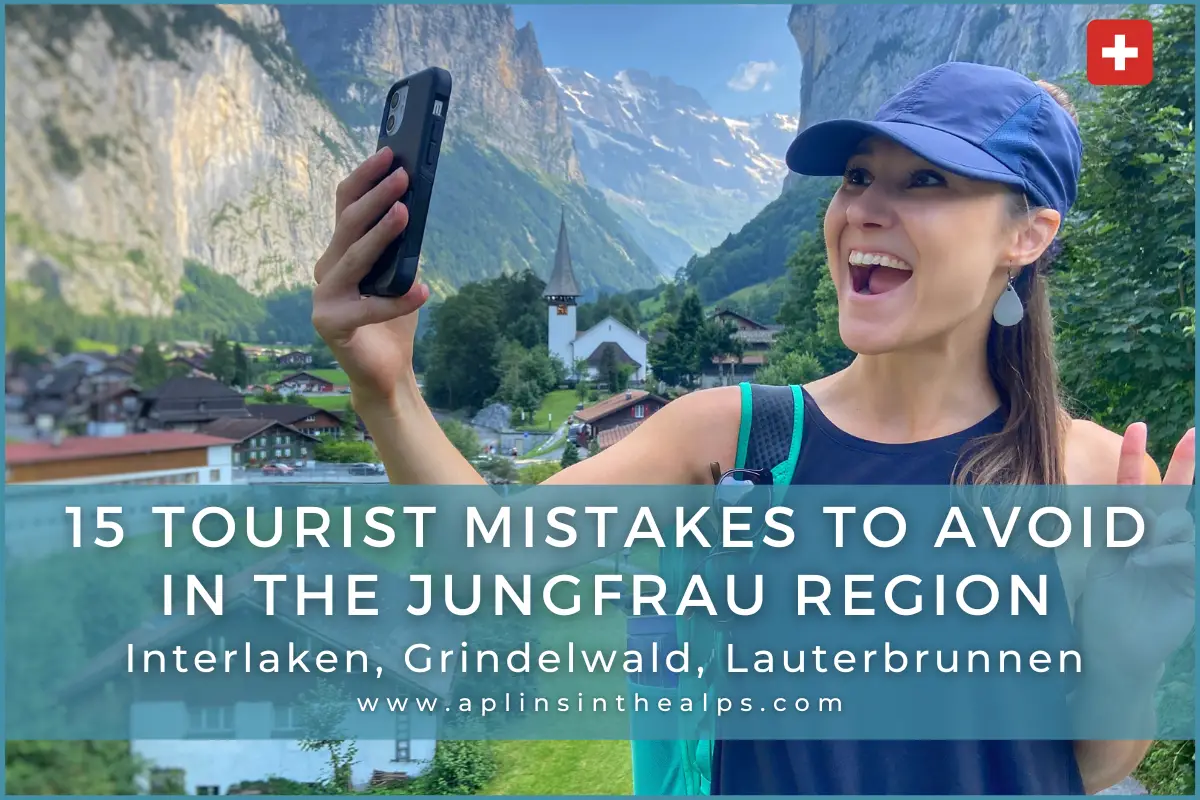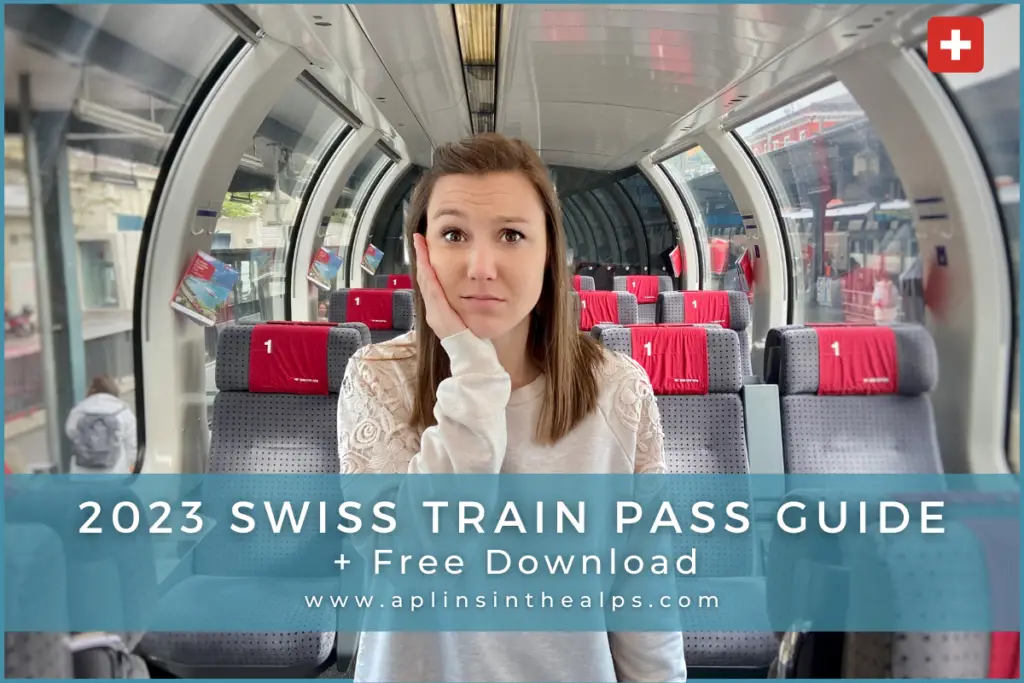Going to Interlaken, Grindelwald, Wengen, or Lauterbrunnen? Avoid these 15 tourist mistakes so you don’t look and feel like a total newbie!
Want to Watch Instead of Read?
1 | Don’t prioritize Jungfraujoch over everything else
Let’s start with something controversial. Jungfraujoch is without a doubt the most well-marketed spot in the area, with loads of Swiss Francs deployed every year to convince travelers like you that your trip won’t be complete without a visit to the Top of Europe.
We’ve been to Jungfraujoch a few times now, and we made a video there last year. And if you watch it, I think you’ll see that we had a ton of fun.
But so many travelers have asked us if Jungfraujoch is worth it. It’s not a mistake to go there — if you know you wanna visit, do it! But we do think it’s a mistake to prioritize it over everything else.
The reality is that Jungfraujoch is the most expensive place to visit near Interlaken, a trip there takes a big chunk of a day, and there are good views up there but we think the views are better elsewhere.
But if you have never seen snow, this is a great chance to enjoy that experience! And if you want to see or hike across a glacier, then you won’t want to miss Jungfraujoch.
So enjoy Jungfraujoch guilt-free if you know you wanna go there. But we don’t recommend it if you have less than 3 days in the Jungfrau region. There are just too many incredible experiences you’ll have to miss out on to make that happen. Not to mention that most of them will be fully covered by your train pass too!
(Oh, and don’t take a day trip from Zurich or Geneva just to go to Jungfraujoch if you’ve never even been to the Jungfrau Region at all!!)

2 | Don’t act like a Jungfraujoch rookie
If you do decide to go to Jungfraujoch, avoid looking like a rookie by following these tips:
- The average high temperature, even during the summer months, barely gets above freezing. So make sure to dress appropriately. That means bringing layers — and you might even want gloves and a hat.
- But don’t overdo it by wearing a heavy coat and no other layers. When the sun is shining during the summer, it can feel much warmer than the actual temperature suggests.
- The coldest part of the entire Jungfraujoch tour might just be the Ice Palace, which is kept at 27°F the entire year!
- Try to avoid a weekend visit if possible
- Go early in the morning. This will put you ahead of the crowds and give you a much better experience.
- Finally, it would be a mistake to go to Jungfraujoch without watching our ultimate guide where we tell you everything you need to know, like how to hike on a glacier, where to pose with the Swiss flag in the snow, how to mail a letter from the highest mailbox in Switzerland, among other things!
3 | Don’t use your phone’s weather app
There’s no way to be nice about it — the phone weather app sucks at predicting what the weather is actually going to be like in the Swiss Alps.
There are plenty of days here when we’re outside enjoying the bright sunshine while our apps literally tell us it’s raining. And if you were to believe your phone’s unreliable weather app, you’d often miss out on a beautiful day in the mountains!
So do yourself a favor and get familiar with MeteoSwiss. There is an app, but we find the website to be more user-friendly. MeteoSwiss seems to deliver the most accurate weather forecasts, and one of our favorite features is the ability to see the expected minutes of sunshine or precipitation per hour.
This is so helpful when you want to prioritize the clearest part of the day for an exciting mountain adventure.
And be sure to check the weather in a few different places — for example the lakes versus the mountains — because it can often be cloudy in one area but sunny in another.
So don’t visit Interlaken or Grindelwald, or really anywhere in Switzerland, without making MeteoSwiss your friend!
4 | Don’t go to the wrong train station
Trains can already feel complicated, but Grindelwald and Interlaken and Mürren make your train travel extra confusing by having multiple stations with similar names.
Interlaken has two train stations.
- Interlaken Ost, which means “east,” and Interlaken West, which means…west.
- Interlaken West has more hotels, restaurants, and amenities, but Interlaken Ost is the beginning of the train line heading into the mountains. You can connect between the two by train, or by walking approximately 15 minutes.
- Or you can ride a bus from Interlaken West to Wilderswil where you can then catch the train to go to the mountains.
There are actually three train stations in Grindelwald, and you need to know which one is closest to your hotel, and which is best for other sightseeing excursions.
- When you travel toward Grindelwald, the first station you’ll come to is Grindelwald Terminal. This is where you get off to board the Eiger Express to Eigergletscher and then head to Jungfraujoch, or to take the cable car to Männlichen.
- One station past Terminal is the Grindelwald Bahnhof train station. This is the main village, where nearly all the lodging is, and you’ll also find the Grindelwald First and Pfingstegg cable cars about a 10-15 minute walk or short bus ride from here.
- Finally, there’s Grindelwald Grund, sitting just below the main village. You have to switch trains in Grindelwald to go here, and less of you are likely to use this station. But it might be convenient if your Airbnb sits below the village or if you want to ride the train to Kleine Scheidegg.
And then there’s Mürren.
- This delightful alpine village is serviced by the BLM from the Lauterbrunnen train station, and by the Schilthorn cable car from Stechelberg at the back of the valley.
So yeah…maps are very helpful here! Nearly every station in this region has giant Switzerland maps on the walls and all of them have paper copies inside as well.
5 | Don’t stand in the wrong line at Harder Kulm
While we’re on the topic of being in the wrong place, make sure you hop in the correct line when you visit Harder Kulm.
The left side is for people who already have a ticket (or a pass) that covers the ride, while the right side is for people who need to purchase a ticket — and it’s often much longer.
But there’s no excuse to have to stand in that line. Both regional train passes — the Berner Oberland Pass and Jungfrau Travel Pass — fully cover this route. And if you don’t have one of those passes, it’s extremely easy to buy tickets using the SBB mobile app, or even online.
6 | Don’t assume all the cable cars run year-round
Few things are worse than traveling all the way to Interlaken just to find out that the places you are most excited to visit are closed. So avoid this mistake by looking up the cable car and railway operating schedules before your visit.
There are distinct summer and winter seasons here, and many of the major mountain adventures are accessible during each.
But in between, “shoulder season” is a real thing, with plenty of places closed for maintenance for up to six weeks at a time. Keep in mind, too, that some sightseeing favorites such as Harder Kulm and Schynige Platte are only open for the summer season.
Now, no matter what time of year you visit, you’ll be able to enjoy the villages of Interlaken, Lauterbrunnen, Grindelwald, and Wengen. And while mountain villages like Mürren and Gimmelwald are accessible year-round, they often have limited restaurant and lodging amenities to offer during the shoulder seasons.
But there are definitely periods of time throughout the year that are more likely to delight — or disappoint — your expectations. So be sure to check out our “Best Time to Visit Interlaken” video and blog, which has month-by-moth details to aid you in your planning!
7 | Don’t come without a plan
While unexpected cable car closings and poor weather forecasts can ruin your trip, so can a “wing-it” approach to your sightseeing plans.
We commonly see tourists making this mistake by trying to pack a week’s worth of sightseeing into 3 days, not realizing how long it takes to get from one place to another or assuming cable cars run late in the day — even when they don’t.
But we also sadly watch too many people miss out on incredible experiences because they’re single-mindedly focused on following the crowds to replicate that perfect Instagram photo or movie scene.
Now there’s no reason you can’t enjoy the best this region has to offer and have the trip of a lifetime, even with just a few days. But you’re gonna need some help.
And that’s why we created our Switzerland itineraries for the Jungfrau Region. They solve all these problems and prevent you from making so many of the mistakes we mention in this video. So be sure to check those out later — but not before reading the rest of these tips.
8 | Don’t misunderstand the trail signs
It’s easy to be lulled into complacency while hiking in Switzerland. The nature is stunning, cable cars and trains will take you just about anywhere you want to go, and the trails are so well marked, it’s nearly impossible to get lost.
But that doesn’t mean you should be unprepared. So get familiar with the trail signs and their markings.
Yellow trails are the easiest, and usually suggest a paved path or wide gravel trail suitable for walkers of almost all ability levels. Generally, tennis shoes should be just fine for these paths.
Red trails are hiking trails, and usually include more elevation gain or loss, narrower trails with rocks and roots on the path, and sometimes a little bit of exposure too. You’re better off with at least a trail running or light hiking shoe as opposed to tennis shoes on these trails.
And then you have blue trails. I hesitate to even mention this because only those with lots of experience and the proper equipment should even venture onto blue trails. They’re considered alpine trails, and often require fixed ropes or other equipment to navigate difficult areas with lots of exposure, and significant threat of falls.
In addition to these color markings, you’ll see a few places listed along with time estimates to reach them at an average (but Swiss-centric) hiking pace.
Keep in mind that your end destination might not be listed on these signs from the beginning of your hike, so you’ll probably need to know some of the main waypoints along the route. If you’re unsure, you can find a trail map in any of the train stations.
9 | Don’t go out without a (properly packed) daypack
You’re in the alps. A typical day can include crisp, clear mornings, clouds rolling in by noon, a brief rainstorm in the afternoon, followed by hot, muggy sunshine until the sun sets — when it then cools off more quickly than you’d imagine.
Mix in the altitude changes while you’re sightseeing and, basically, there is no typical weather here! So pack for a little of everything!
- We usually wear a t-shirt and a long-sleeve pullover when we head into the mountains during the summer.
- And we always, always take a rain jacket!
- But if we’re going up above 2000m, we’ll probably bring along a sweatshirt for warmth as well.
- When the sun is out, it can feel HOT even at 60 degrees.
- But if the clouds roll in or the wind picks up, it can quickly feel like 40. So just be ready for all types of temperatures.
- Oh and don’t forget your sunscreen too. Or at least wear something stylish for sun protection like Brett.

10 | Don’t wait in long lines for the Grindelwald First Adventure Activities
Many of you are excited for the Adventure activities at Grindelwald First. And not to rain on your parade, but we’ve pretty much always seen wait times of 90-120 minutes for most of these activities by mid-morning.
So to avoid wasting a day in the Swiss alps standing in line for these activities, we suggest the following strategy:
- Go first thing in the morning. The gondolas begin running between 8-9 depending on the time of year, and, once again, you’ll beat the crowds by going early.
- Choose one of these three activities that’s most important to you — the glider, flier, or the mountain carts — and do it right away. Ride up to Schreckfeld if you want to do the glider or mountain carts, or all the way up to First for the flier.
- Once you get your most important adventure activity out of the way, you can decide whether or not to do another based on the wait times.
But you’ll notice we didn’t list the trottibike. That’s because, for whatever reason, it almost never has a long wait time. So it’s actually pretty strategic to save this for the end, and ride the trottibike all the way back to Grindelwald.
Just like with Harder Kulm, both of the regional train passes fully cover the gondola rides to First, or you can buy tickets on the SBB mobile app or online. So there is no reason to stand in line to purchase them.
And you can even buy tickets online for the adventure activities too, though we suggest caution here — we’d hate to see you load up on tickets only to spend all day waiting in line to complete these activities!
11 | Don’t get on wrong train to Grindelwald/Lauterbrunnen
Whether you’re traveling to Grindelwald or Lauterbrunnen, you’ll board from the same platform in the Interlaken Ost and Wilderswil train stations. If you’re headed to Lauterbrunnen, you’ll wanna be in the front. But if you’re going to Grindelwald, you need to be in the back of the train.
That’s because the train carries all passengers together to Zweilütschinen, but then it splits, with the front half continuing to Lauterbrunnen and the back half going to Grindelwald.
There are signs at both the Interlaken Ost and Wilderswil train stations that are super clear, but we still see people making this mistake, providing a little free entertainment for everyone seated in the correct part of the train!

12 | Don’t miss the “real” Lauterbrunnen Valley
You don’t have to be J.R.R. Tolkien or an Instagram influencer to recognize that Lauterbrunnen Valley is one of the most stunning places on earth. So a visit here is a must.
But if you only stick to the village and Staubbach waterfall, you’ll be missing the best part!
So take your time and wander the paved path that goes past Staubbach Falls and continues toward the back of the valley.
Along the way you’ll pass local farms, wind along beside the river, and have the chance to visit some farm fridges. But you’ll also give yourself a sore neck as you continually gaze at the endless waterfalls and sheer cliff faces.
It’s about 5km from the Lauterbrunnen train station to the Stechelberg Schilthornbahn near the back of the valley. But at many points along the way, you can cross the river and hop on a bus if you’d rather cut the walk short.
Or if you wanna enjoy the valley at your own pace while saving your walking legs, consider renting a bike at Imboden Bike in Lauterbrunnen!
13 | Don’t Visit the Schilthorn but skip the Birg Thrill Walk
The Schilthorn is iconic, with its revolving restaurant offering up some of the most killer views in the Jungfrau Region on a clear day.
And the fact that it was a filming location for James Bond On Her Majesty’s Secret Service is just icing on the cake.
But why visit the place inspired by James Bond without pretending to BE James Bond?
Do your best Bond impersonation by stopping at the Birg cable car station for the Birg Thrill Walk. You’ll walk along cliff faces, cross a tight-rope, and crawl through a tunnel — all while safely suspended by the magnificence of Swiss engineering.
There are ways to bypass each of the “scarier” elements. But really, unless you’re afraid of heights, there’s nothing particularly scary or dangerous about this. And in our opinion, this is an even cooler experience than the Cliff Walk at Grindelwald First (although, that’s fun too!)
The thrill walk is free with your cable car ticket (or by hiking!), and you can stop at Birg to enjoy this activity on the way to or from the Schilthorn.

14 | Don’t think you can drive everywhere
You really don’t need a rental car in the Jungfrau Region. Of course you can drive to Interlaken, Grindelwald, and Lauterbrunnen.
But here’s an incomplete list of places you CAN’T get to by driving: Wengen, Mürren, Gimmelwald, Grindelwald First, the Schilthorn, Jungfraujoch, Harder Kulm, Männlichen, Schynige Platte — and the list goes on!
There are times when it makes sense to drive to this area, for example, if you’re traveling with a larger group or you’ve already rented a car to visit other European destinations.
But even if you drive to the Jungfrau Region, you’re still gonna have to ride public transportation to go into the mountains, it’s going to cost quite a bit of money, and it probably still makes sense to buy a train pass of some kind.
15 | Don’t forget to buy a train pass (and don’t buy the wrong one)
Not buying a Swiss Train Pass is like throwing your Swiss Francs in the garbage.
But there are so many different passes to choose from, and knowing which rides are and aren’t covered by each pass can be VERY confusing.
So instead of buying the Swiss Travel Pass and just hoping it works out, check out our Ultimate Guide to Swiss Train Passes.
In the video, blog, and free download, we make specific recommendations for loads of trips to the Jungfrau Region, Zermatt, Luzern, and beyond, so you can pick your pass and travel Switzerland with confidence.
We’ll see ya in Switzerland!





We are coming in Sept for 16 days, all your videos are excellent, thank you for your funny and real way of helping us. Jim and Vin